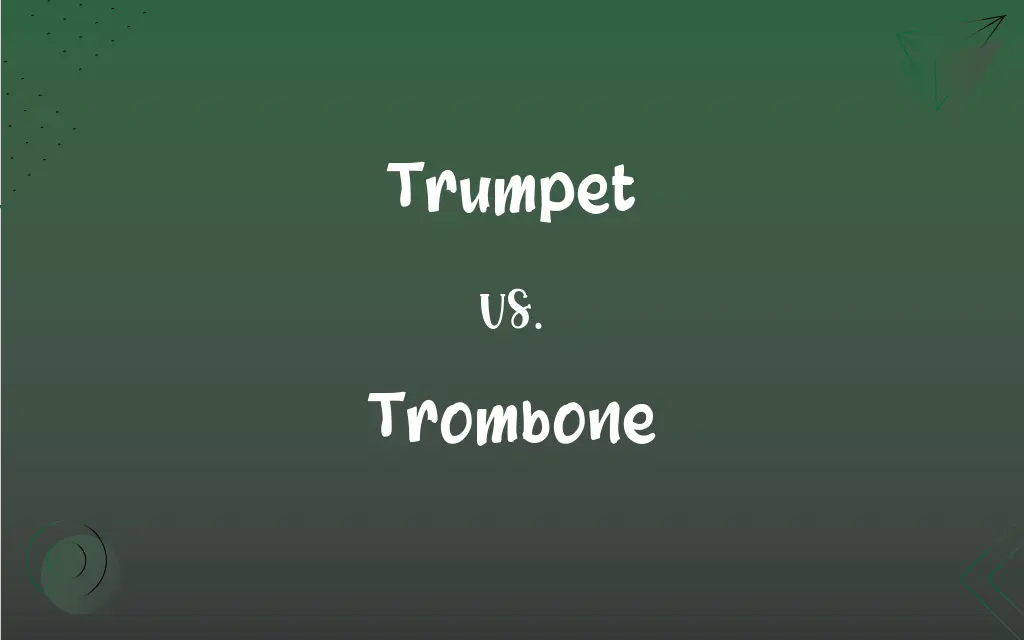Trumpet vs. Trombone: What's the Difference?
Edited by Aimie Carlson || By Janet White || Published on May 11, 2024
A trumpet is a brass instrument with valves for changing pitch, while a trombone uses a slide to alter pitch.

Key Differences
The trumpet and trombone are both essential members of the brass family, each with distinctive features and playing techniques. The trumpet is known for its bright, piercing sound, achieved through its tightly coiled tubing and three valves that change the pitch. In contrast, the trombone produces a deeper, more mellow tone, courtesy of its longer and more openly curved tubing. Unlike the trumpet, the trombone uses a slide mechanism to change pitch, allowing for smooth transitions between notes known as glissandos.
The trumpet typically plays higher parts in music due to its brighter tone and higher register, the trombone often handles lower parts, providing depth and richness to musical ensembles. Both instruments require significant breath control, but the trombone's slide mechanism demands precise arm movement and coordination for accurate pitch changes.
The physical differences between the trumpet and trombone are apparent not only in their sound production but also in their size and shape. The trumpet's compact form makes it more portable and less visually obtrusive, while the trombone's larger size and extending slide make it more conspicuous. These physical characteristics also influence the playing posture and techniques required for each instrument.
Despite their differences, both the trumpet and trombone share a common heritage in the brass family, with roots in early musical history. They complement each other in orchestras, bands, and smaller ensembles, contributing to the rich tapestry of sounds that define brass music. Whether in a jazz band, marching band, or symphony orchestra, the trumpet and trombone continue to be celebrated for their distinct voices and roles in music.
Comparison Chart
Pitch Change Mechanism
Valves
Slide
ADVERTISEMENT
Tone
Bright and piercing
Deep and mellow
Range
Higher
Lower
Size and Portability
Smaller and more portable
Larger with an extending slide
Typical Musical Roles
Melodic and harmonic, higher parts
Lower parts, rich harmonies
Trumpet and Trombone Definitions
Trumpet
Trumpets are used in a wide range of music genres.
From classical to jazz, the trumpet shines in diverse musical settings.
ADVERTISEMENT
Trombone
The trombone uses a slide to vary the pitch.
He extended the trombone's slide to reach the lower notes.
Trumpet
A trumpet is a brass instrument with a bright, clear sound.
He played a solo on the trumpet that captivated the audience.
Trombone
A trombone is a brass instrument with a rich, full tone.
The trombone's deep sound enriched the orchestra's performance.
Trumpet
In many bands, the trumpet often plays the lead melody.
The trumpet took the lead in the band's rendition of the song.
Trombone
The trombone's slide allows for smooth note transitions.
The trombonist's expressive slides added a unique quality to the piece.
Trumpet
The trumpet uses valves to change pitches.
She practiced changing notes quickly on her trumpet by pressing its valves.
Trombone
Trombones excel in playing lower-pitched music.
The trombone section provided a solid foundation with their lower register.
Trumpet
The trumpet is known for its ability to play high notes.
The trumpet's high register added excitement to the music.
Trombone
Trombones typically play supportive and harmonic roles in ensembles.
In the jazz ensemble, the trombone added depth with its harmonies.
Trumpet
(Music) A soprano brass instrument consisting of a long metal tube looped once and ending in a flared bell, the modern type being equipped with three valves for producing variations in pitch.
Trombone
A brass instrument consisting of a long cylindrical tube bent upon itself twice, ending in a bell-shaped mouth, and having a movable U-shaped slide for producing different pitches.
FAQs
What is a trumpet?
A trumpet is a brass instrument with valves for changing pitch, known for its bright tone.
How does a trombone change pitches?
A trombone changes pitches by moving its slide in and out.
How do you change notes on a trumpet?
Notes on a trumpet are changed by pressing combinations of its three valves.
What defines a trombone?
A trombone is a brass instrument with a slide mechanism for pitch variation, known for its deeper sound.
What types of music are trumpets used in?
Trumpets are used in classical, jazz, pop, and marching band music, among others.
Is the trumpet higher in pitch than the trombone?
Yes, the trumpet generally plays in a higher register than the trombone.
Are trumpets considered lead instruments?
In many ensembles, trumpets often play lead melodies.
What's the role of trombones in an orchestra?
Trombones typically provide harmonic support and depth in an orchestra.
How does the trombone contribute to a jazz band?
The trombone adds depth and slide effects in a jazz band.
Can trombones play fast passages easily?
Fast passages are possible on the trombone but require skillful slide manipulation.
Can a trumpet play a glissando?
Trumpets can approximate a glissando using valves, but it's not as smooth as on a trombone.
How does a trumpet produce sound?
Sound is produced on a trumpet by buzzing lips into a mouthpiece and using valves.
Is the trumpet part of a jazz ensemble?
Yes, the trumpet is a key instrument in jazz ensembles.
What's the difference between a trumpet's and a trombone's mouthpiece?
A trumpet's mouthpiece is smaller and more shallow than a trombone's, affecting the tone and playability.
Can beginners start with either instrument?
Yes, beginners can start learning music with either the trumpet or the trombone, depending on interest and physical comfort.
Do trombones have valves?
Some trombones have a valve attachment, but their primary mechanism is the slide.
What is a glissando on the trombone?
A glissando is a smooth slide between notes, a technique characteristic of the trombone.
What's the typical range of a trombone?
The trombone has a wide range, extending from high to very low notes.
How do you clean a trumpet?
A trumpet is cleaned by disassembling and washing the parts, then oiling the valves.
How is a trombone cleaned?
A trombone is cleaned by disassembling it and using a cleaning rod and cloth for the slide and tubing.
About Author
Written by
Janet WhiteJanet White has been an esteemed writer and blogger for Difference Wiki. Holding a Master's degree in Science and Medical Journalism from the prestigious Boston University, she has consistently demonstrated her expertise and passion for her field. When she's not immersed in her work, Janet relishes her time exercising, delving into a good book, and cherishing moments with friends and family.
Edited by
Aimie CarlsonAimie Carlson, holding a master's degree in English literature, is a fervent English language enthusiast. She lends her writing talents to Difference Wiki, a prominent website that specializes in comparisons, offering readers insightful analyses that both captivate and inform.






































































